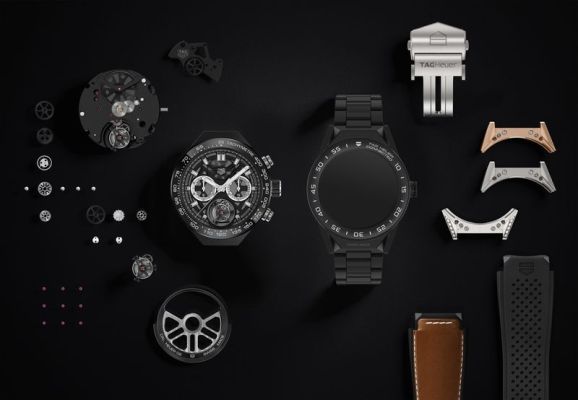Emboldened by the surprise success of its $1,500 Connected smartwatch, Tag Heuer is back with something even more expensive. Starting at around $1,650, the Connected Modular 45 once again finds the luxury Swiss watchmaker teaming up with Google and Intel, and this time living up to the “avant-garde” bit of the company’s tagline a touch more with a truly modular design.
That’s in-line with claims made by Tag’s CEO back in January, regarding the company’s forward-looking take on the staid world of smartwatches. What it means in practice is that those willing to pony up several times the price of your standard Android Wear device will get an extreme level of customization ahead of purchase.
Buyers will be able to pick from among all different sorts of colors, buckles and modules. It’s a key break from most smartwatches on the market, which, at best, offer a few different color options. All told, there are 500 different design combinations for the thing, according to Tag. Perhaps most compelling is the company’s trade-in program, which lets users swap the connected Android Wear module for something more traditional like the company’s Tourbillon Heuer 02-T.
It’s a clever addition to the system that flies in the face in the sort of forced obsolescence of other smartwatches, which have applied the two-year upgrade cycle borrowed from their smartphone counterparts. It’s one thing when you’re talking about a $200 watch — it’s another when it’s eight times that price.
“This is a Swiss watch which embodies the luxury codes of tomorrow, and which not only enables you to connect to the future, but also to connect to eternity thanks to its simple and smart modular design,” CEO and president of Tag’s LVMH Watch Division, Jean-Claude Biver said in a sufficiently hyperbolic statement attached to the unveiling. “This innovative, unique and distinctive watch is at the forefront of the latest technologies available in Silicon Valley and, at the same time, a genuine Swiss watch, bearing the Swiss Made label. It is the incarnation of our leading position with luxury connected watch and with this high level of technology.”
Of course, the watch will run Android Wear 2.0, the much delayed version of Google’s wearable operating system that brings it up to speed with the likes of Apple’s watchOS and Samsung’s Tizen fork. That’s running on Intel’s Atom Z34XX processor. The partnership with the chip company also means the watch will eventually run its upcoming intelligent assistant.
That piece still seems a bit of a mystery at the moment. Like a number of other manufacturers, the companies are shying away from simply embracing Google Assistant, one of the biggest new features of Wear 2.0. It’s clear why Intel is going that route — the company has clearly had some stumbles in the wearable space of late, and partnerships with Tag and Oakley present the potential to gain a foothold without having to invest too heavily in their own hardware. Ahead of launch, Intel is claiming that its own in-house AI will offer up even better contextual info than the likes of Assistant or Siri.
As for why Tag is so committed to smartwatches at a time when the market appears to have, at best, plateaued, the Swiss watchmaker is clearly emboldened by the 56,000 units it managed to sell last time around. Granted, that’s not a huge number, but when you’re charging several times the cost of your average Android Wear device, you can get away with being a successful niche.
There’s NFC on the device, and the company has managed to make it waterproof to 50 meters. But there are certain now-standard smartwatch features like GPS and heart-rate monitoring that are conspicuously absent. Though it was already pretty safe to say the company wasn’t exactly edging in on Garmin territory with this one.
The notion of a $1,600 Android Wear device remains, as ever, hard to swallow. But at the very least, Tag is going out of its way to shake up a market full of dull and overly large devices. And if the last version of the Connected taught us anything, it’s that the market for such devices (while modest), does apparently exist.
